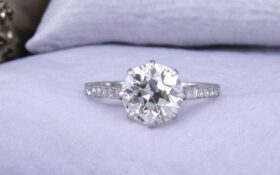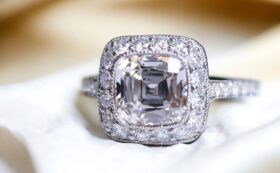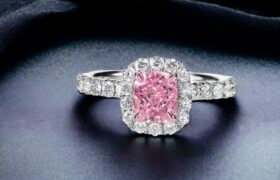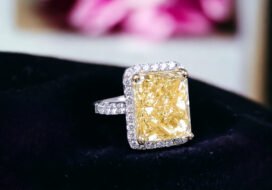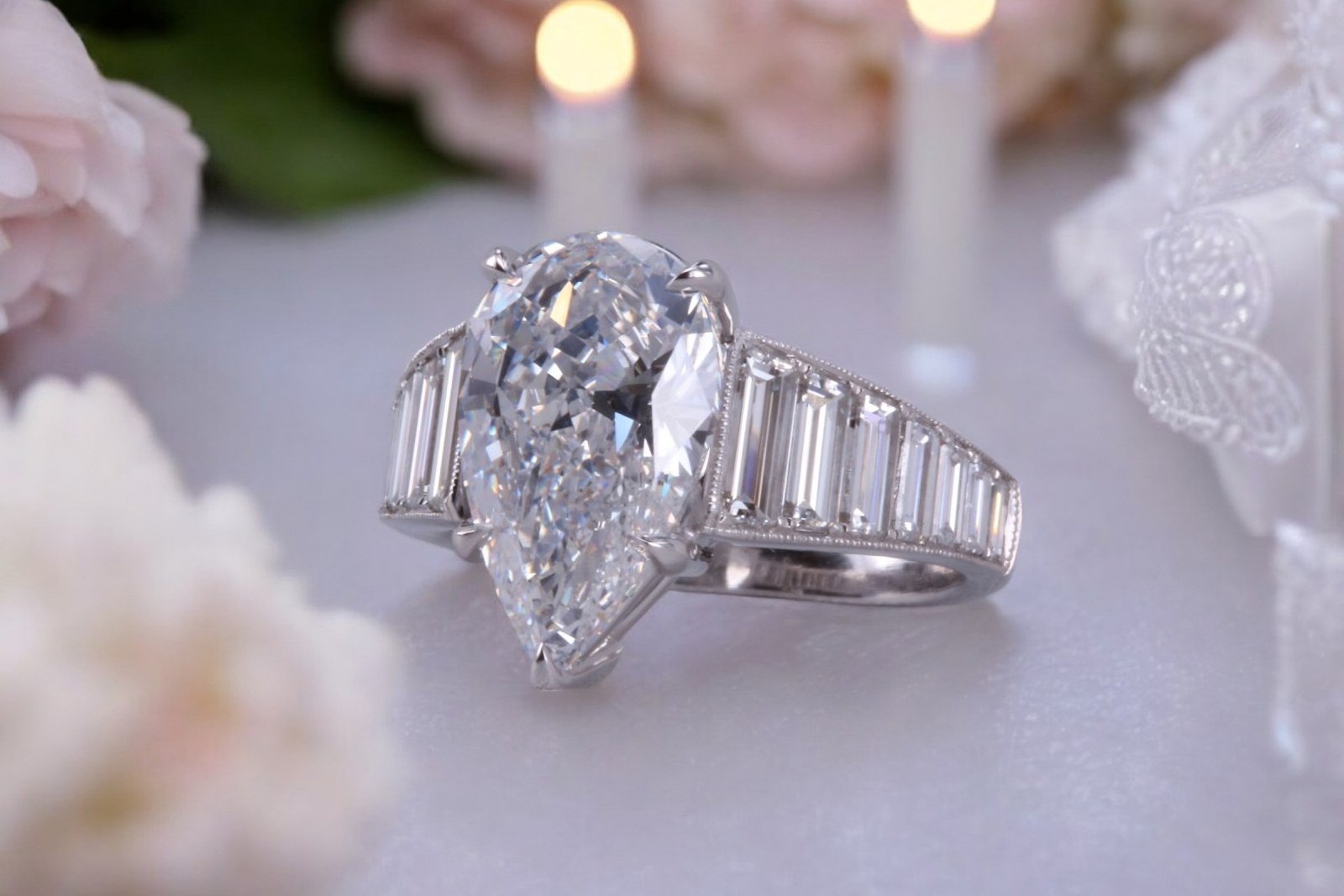
20 Jul Pear Diamond Rings & Jewelry – All Your Need to Know
Seen Above: A Pear-Shaped Diamond Ring in Platinum Setting, Designed by Carl Blackburn
When couples work with Carl Blackburn on a custom engagement ring, they often ask for guidance on the perfect diamond shape. While this choice can vary, depending on ring design and the personal preferences of the wearer, many women today are enchanted by pear shape diamonds, which stand out with their unique elegance and timeless charm.
Also called the teardrop cut, this shape combines a brilliant round end with a tapered point. It’s a shape that flatters, catches the light beautifully, and adds a touch of romance to any piece.
Whether you’re designing an engagement ring that symbolizes everlasting love or looking for earrings of a pendant that adds character to everyday wear, pear diamonds bring versatility and refinement to jewelry of all kinds.
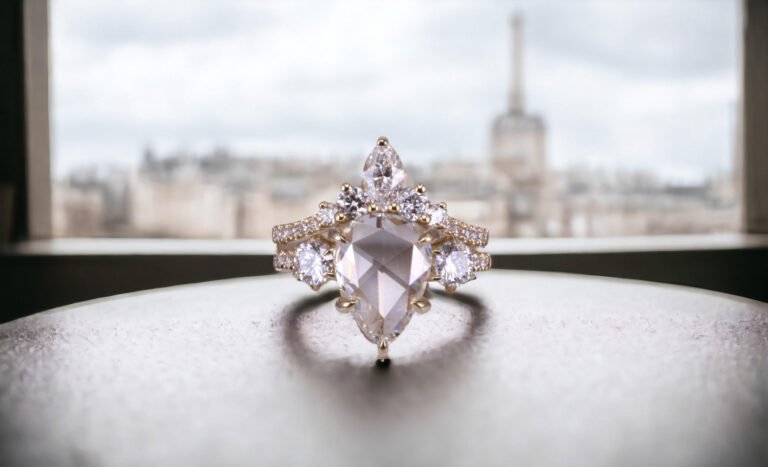
The Distinctive Shape of Pear Diamonds
The pear diamond’s shape is what makes it truly special. Merging elements of both round and marquise cuts, it creates a soft teardrop outline that reflects light with exceptional brilliance. Its elongated form also has a flattering effect, making fingers appear longer and more slender — an especially appealing trait in engagement rings.
When properly cut, a pear diamond has beautiful symmetry between its rounded and pointed ends. This balance isn’t just aesthetic — it plays a key role in how the diamond sparkles. However, pear shapes are also prone to what’s known as the “bow-tie effect” — a dark shadow across the center that can appear if the proportions aren’t ideal. A well-cut stone minimizes this effect, ensuring even sparkle from all angles.
Thanks to their shape, pear diamonds lend themselves to a wide range of creative settings, from sleek solitaires to more elaborate designs. They’re a popular choice for those seeking a look that’s elegant yet slightly unconventional.
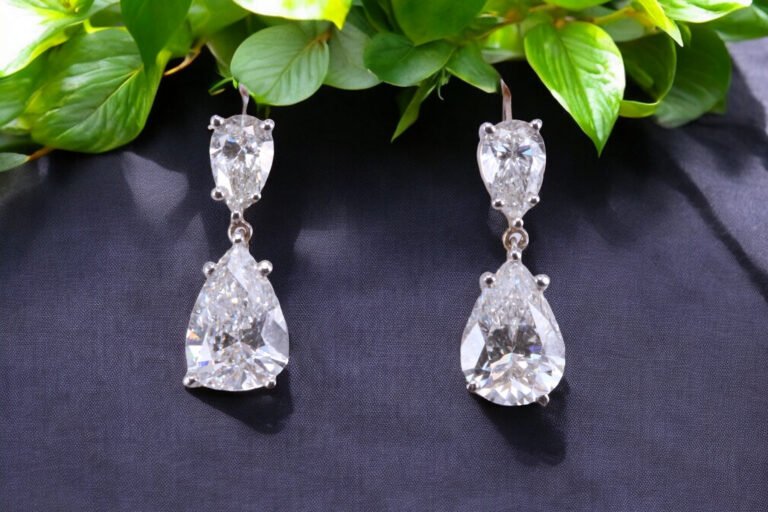
A Storied History
The pear-shaped diamond has roots going back to the 15th century, when Flemish polisher Lodewyk van Bercken developed the scaif, a revolutionary polishing wheel that allowed for more precise and symmetrical diamond cuts. This innovation paved the way for the pear shape — a blend of the newly mastered round cut with the elongated marquise.
Over the years, this distinctive shape became a favorite among European nobility and royalty, admired for its graceful silhouette and rich sparkle. One of the most famous pear-shaped diamonds in history is the Star of South Africa, a 47.69-carat gem discovered in 1869. It played a major role in launching South Africa’s diamond industry and cemented the pear cut’s status as a symbol of luxury and refinement.
Other legendary pear-shaped diamonds include the 69.42-carat Taylor-Burton Diamond, famously gifted to Elizabeth Taylor by Richard Burton — adding a layer of Hollywood glamour to the stone’s romantic appeal.
Today, pear diamonds remain a sought-after shape in both classic and contemporary designs, favored by celebrities and collectors alike.
Why Choose a Pear-Shaped Diamond Ring?
One of the biggest draws of a pear-shaped diamond is its eye-catching brilliance. With its many facets and elongated form, this shape captures light beautifully, creating an impressive display of fire and sparkle.
The shape also offers great visual impact per carat. Thanks to its length, a pear diamond can appear larger than other shapes of the same weight — making it a smart option for those looking to maximize size without increasing cost. And because of its tapered point, inclusions near the tip can often be hidden by a prong, offering more flexibility when choosing a stone with natural imperfections.
Another advantage is design flexibility. Pear-shaped diamonds can be worn with the point facing up or down, depending on the desired look. Some believe wearing the point toward the heart symbolizes emotional connection, while others prefer it facing out for a bold, modern aesthetic.
The shape lends itself beautifully to pendants and earrings as well — where the teardrop effect creates graceful movement and visual flow. Pear diamonds are also comfortable to wear, but it’s important that the pointed end be well-protected (either by a V-prong or bezel) to reduce the risk of chipping during daily wear.
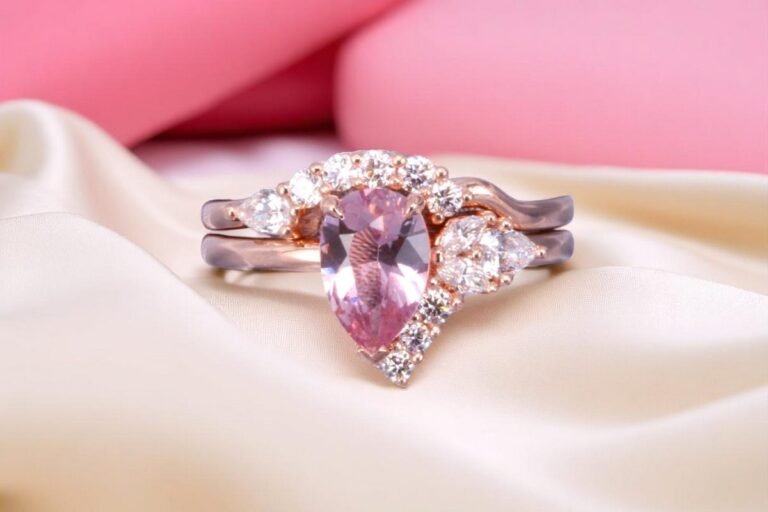
Pear-Shaped Diamond Ring Styles & Settings
Pear-shaped diamonds are incredibly versatile when it comes to style. One of the most enduring options is the solitaire setting: simple, elegant, and designed to let the diamond take center stage. A clean metal band complements the elongated stone, making it ideal for those who appreciate understated sophistication.
For added glamour, the halo setting surrounds the pear diamond with smaller accent stones. This not only enhances the center stone’s size and sparkle but also adds depth and dimension. Halo settings can be tailored with different diamond shapes or colored gems for a more personalized touch.
The three-stone setting is another timeless choice. Often symbolizing the past, present, and future, this design places the pear diamond between two complementary stones, such as round or marquise diamonds. It’s a meaningful style, perfect for both engagements and anniversaries.
Additional setting considerations include east-west orientations (with the point facing sideways), which offer a modern twist, and split shank bands that frame the stone beautifully and add architectural interest.
Current Design Trends
Designers are finding new ways to reinvent the pear shape for modern tastes. One trend gaining momentum is the use of colored pear diamonds. From soft pinks to bold yellows and blues, these vibrant stones offer a striking alternative to traditional white diamonds. They’re often favored by celebrities and individuals looking for something truly unique.
Mixed metal settings are also popular, combining white, yellow, and rose gold in one piece to create visual contrast and depth. Add to that intricate details like milgrain edges, hand engraving, or filigree work, and you get a piece that feels both custom and classic.
For lovers of antique style, vintage-inspired designs are back in the spotlight. These rings draw from eras like Art Deco and Victorian, often featuring symmetrical patterns and extra gemstone accents like sapphires or emeralds. Paired with a pear-shaped diamond, the result is timeless, romantic, and full of personality.
Stackable rings are also trending, allowing pear diamond rings to be paired with curved or chevron bands that nestle perfectly against their shape — adding versatility and visual intrigue.
Lastly, remember that a pear-shaped gemstone isn’t limited to diamonds. Colored gems such as ruby, sapphire, morganite, and aquamarine are also popularly cut into pear shapes and set into an engagement ring as the main stone with small diamond accents.
Choosing the Right Pear Diamond
When selecting a pear diamond, cut quality should be your top consideration. Look for a stone with good symmetry between its two ends and an even outline. A well-cut pear diamond should have a pleasing, balanced shape — not too wide or narrow — and should sparkle evenly across the surface.
Clarity is also important. While pear-shaped diamonds can sometimes hide small inclusions (especially near the point), you’ll want to examine the stone from different angles and lighting conditions to be sure you’re happy with its overall appearance.
Color is somewhat subjective, but keep in mind that the pear shape can reveal color slightly more than round cuts. A near-colorless grade (such as G or H) often looks great, though some buyers prefer the warmth of slightly lower grades — especially in vintage settings.
Don’t forget to ask about durability. Due to its pointed tip, a pear diamond should always be mounted in a way that provides protection. And like all fine jewelry, it benefits from occasional professional cleaning and inspection to maintain its brilliance and structural integrity.
Finally, think about carat weight in relation to your design and budget. Because pear diamonds look larger per carat, you may be able to go slightly smaller without sacrificing visual impact. However, if you would like a larger stone, keep in mind that pear-shaped lab grown diamonds are available at a fraction of the price of an earth mined diamond (while being just as radiant, strong, and beautiful).
Let’s Create Your Dream Ring
Are you ready to work with La Jolla jewelry designer Carl Blackburn on a custom pear diamond engagement ring? Call us at 858-251-3006 or send a text message to 619-723-8589. You can also contact us by email via the contact from below.

